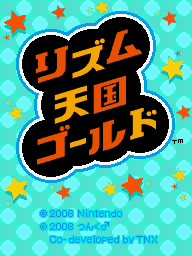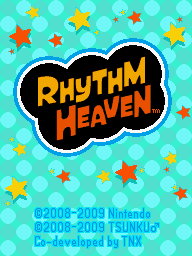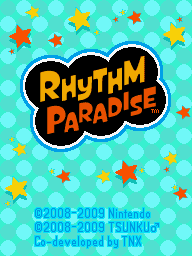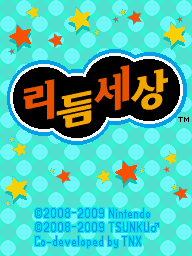Rhythm Heaven/Development: Difference between revisions
mNo edit summary |
mNo edit summary |
||
| (10 intermediate revisions by 3 users not shown) | |||
| Line 1: | Line 1: | ||
{{Development}}{{ | {{Development}}{{TCRF|Rhythm Heaven|Rhythm Heaven}} | ||
{| class="wikitable" align="center" style="width:100%; text-align:center" | {| class="wikitable" align="center" style="width:100%; text-align:center" | ||
!Title | !Title | ||
|''[[Rhythm Tengoku Gold]]'' | |[[File:Screenshot DS Title JP.png|frameless|center]] ''[[Rhythm Tengoku Gold]]'' | ||
|[[File: | |[[File:Screenshot DS Title.png|frameless|center]] ''[[Rhythm Heaven]]'' | ||
|''[[Rhythm Paradise]]'' | |[[File:Screenshot DS Title EU.png|frameless|center]] ''[[Rhythm Paradise]]'' | ||
|''[[Rhythm World]]'' | |[[File:Screenshot DS Title KR.png|frameless|center]] ''[[Rhythm World]]'' | ||
|- | |- | ||
!Region/Languages | !Region/Languages | ||
| Line 20: | Line 20: | ||
|} | |} | ||
==Development History== | ==Development History== | ||
Towards the end of 2004, the team working on ''[[Rhythm Tengoku]]'' wanted to create a version of the game for the [[ | Towards the end of 2004, the team working on ''[[Rhythm Tengoku]]'' wanted to create a version of the game for the [[niwanetwork:Nintendo DS|Nintendo DS]] as well, which had just been released. At the time they could not create a pleasing rhythm game that took advantage of the Touch Screen, so they focused on the [[niwanetwork:Game Boy Advance|Game Boy Advance]] version instead<ref>"ゲームボーイアドバンス用として制作をスタートした『リズム天国』ですが、ちょうどニンテンドーDSが発売されるという時期でしたので、ニンテンドーDS版も視野に入れて制作を進めることにしたんです。当然、ニンテンドーDSでやるからには、タッチパネルを使ったリズムゲームを模索しなければいけない。しかし、そのときはタッチパネルを活かした気持ちのいいリズムゲームが生まれませんでしたので深追いせずに、ゲームボーイアドバンス版だけに注力することになったんです。" ("Rhythm Tengoku" began production for the Game Boy Advance, but it was just at the time when the Nintendo DS was about to be released, so we decided to proceed with production with an eye toward a Nintendo DS version as well. Naturally, since we were going to work on the Nintendo DS, we had to find a rhythm game that used the Touch Screen. However, at that time, we could not create a pleasing rhythm game that took advantage of the Touch Screen, so we decided not to pursue it too deeply and focus only on the Game Boy Advance version.) ~ [[niwanetwork:Katsuya Yamano|Katsuya Yamano]], [https://www.1101.com/nintendo/rythm_heaven2/18.html ほぼ日刊イトイ新聞 - 樹の上の秘密基地。] (Hobo Nikkan Itoi Shinbun - A secret base on a tree.)</ref>. Towards the end of development at the beginning of 2006, the [[niwanetwork:Nintendo DS|Nintendo DS]] became a huge hit, so the staff revisited the idea, however it would've taken a long time to port the work they had already made for the GBA version, and as the game contained previously [[Koi no Honey Sweet Angel|unreleased]] [[WISH Kimi o Matenakute|songs]], they decided not to delay the game. During an interview on September 21, 2006, supervisor [[niwanetwork:Katsuya Yamano|Katsuya Yamano]] teased the idea of a sequel for the [[niwanetwork:Nintendo DS|Nintendo DS]]<ref>"そういうわけでニンテンドーDS版での発売はなくなったかに思えたんですが、『リズム天国』の開発が終盤となったころ、つまり今年のはじめのころに、ニンテンドーDSがご存じのように社会現象になるほど大ヒットしまして、「いま一番勢いのあるゲーム機で発売するべきでは?」という話が持ち上がり、再度検討することになったんです。とはいえ、ゲームボーイアドバンス版でほぼ完成しているものを移植するにしても時間が掛かりますし、一方で、ゲームの中には、時東ぁみさんや、久礼聡史さんが歌う、未発表曲が含まれていて、あまり発売がのびるのもどうか?・・・ということで、最終的にゲームボーイアドバンスでの発売となりました。え? あらためてニンテンドーDSで『リズム天国』の続編を?まあ、そういう声が高まれば‥‥いやいや、軽はずみなことは言えませんね。" (However, toward the end of the development of "Rhythm Tengoku", or at the beginning of this year, the Nintendo DS, as you know, became such a huge hit that it became a social phenomenon, and we thought, "Why not release the game on the console that is currently the most popular?" We decided to reexamine the idea. However, it would take a long time to port the Game Boy Advance version, which was almost completed, and on the other hand, the game included previously unreleased songs sung by Ami Tokito-san and Soshi Kurei-san, so we wondered if we should delay the release too much. So, the game was finally released on the Game Boy Advance. Huh? A sequel to "Rhythm Tengoku" for the Nintendo DS? Well, if people start talking about it...well, I can't say anything rash.) ~ [[niwanetwork:Katsuya Yamano|Katsuya Yamano]], [https://www.1101.com/nintendo/rythm_heaven2/18.html ほぼ日刊イトイ新聞 - 樹の上の秘密基地。] (Hobo Nikkan Itoi Shinbun - A secret base on a tree.)</ref>. | ||
While working on the [[Rhythm Tengoku/Arcade|arcade version]], the developers faced the challenge of figuring out what the next game in the series would be like, which wasn't easy. Director and chief programmer [[ | While working on the [[Rhythm Tengoku/Arcade|arcade version]], the developers faced the challenge of figuring out what the next game in the series would be like, which wasn't easy. Director and chief programmer [[niwanetwork:Kazuyoshi Osawa|Kazuyoshi Osawa]] considered a control mechanic that involved the Touch Screen. The ability to touch the edge of the Touch Screen which would make a tapping sound was considered, but was determined to be too difficult, and so a flicking action was adopted instead. It took a little getting used to, however. Eventually, they realized that combining sound with the flicking action provided a good sense of timing, but they had considered returning to button controls all the while. The flick action took about two to three months for background research and more than six months to eventually adapt the control into ''[[Rhythm Heaven]]''<ref>[https://iwataasks.nintendo.com/interviews/ds/rhythm-heaven/0/2/ Iwata Asks - Rhythm Heaven - Page 3]</ref>. | ||
[[File:Logo DS Rhythm Tengoku Gold Beta.svg|thumb|Pre-release Logo for ''[[Rhythm Tengoku Gold]]'']] | |||
[[niwanetwork:Kazuyoshi Osawa|Osawa]] was in agony trying to figure out how to make the game fun on [[niwanetwork:Nintendo DS|Nintendo DS]]. The team had sent a sample to [[generasia:Tsunku|Tsunku♂]], who really tore it apart. After talking with him, he gave the concept that would eventually become [[Frog Hop]], which became one of the very first games to be made for ''[[Rhythm Heaven]]''. After this, [[generasia:Tsunku|Tsunku♂]] became deeply involved with development, just as he was with the [[Rhythm Tengoku|previous game]]<ref>[https://iwataasks.nintendo.com/interviews/ds/rhythm-heaven/0/3/ Iwata Asks - Rhythm Heaven - Page 4]</ref>. The team as whole was small but with effective leadership, being clear on what ideas are fun to play and which ones need to be scrapped, and sometimes assets would be used in ways the original person who made them could not have expected. [[niwanetwork:Kazuyoshi Osawa|Osawa]] was known to have drawn the original pixel art and written the text, which would later be redrawn by [[niwanetwork:Ko Takeuchi|Ko Takeuchi]] and [[niwanetwork:Kyohei Seki|Kyohei Seki]]<ref>[https://iwataasks.nintendo.com/interviews/ds/rhythm-heaven/0/5/ Iwata Asks - Rhythm Heaven - Page 6]</ref>. The earliest mention of the game to the public came in a [[:File:Tengokugold600.jpg|sell sheet]] detailing Nintendo's 2008 summer release lineup for Japan, including an early Japanese logo for the game, along with early screenshots of [[Built to Scale (DS)|Built to Scale]], [[Glee Club 2|Glee Club]], [[Rhythm Rally 2|Rhythm Rally]], [[Blue Birds]], [[Moai Doo-Wop]], [[Crop Stomp]] and [[Glass Tappers]]<ref>[https://www.wired.com/2008/05/first-blurry-lo/ First Blurry Look at Wario Land Shake <nowiki>|</nowiki> WIRED]</ref>. Sometime later on July 23, 2008, [[generasia:Tsunku|Tsunku♂]] posted on his blog about the game, which would release a week later in Japan, titled ''[[Rhythm Tengoku Gold]]''<ref>[https://ameblo.jp/tsunku-blog/entry-10117485336.html リズム! | つんく♂オフィシャルブログ 「つんブロ♂芸能コース」Powered by Ameba] (Rhythm! | Tsunku♂ Official Blog "Tsunbro♂ Entertainment Course" Powered by Ameba)</ref>. On September 8, 2008, he posted about the release of ''[[Rhythm Tengoku Zen Kyoku-shu]]'', a soundtrack release for both ''[[Rhythm Tengoku]]'' and ''[[Rhythm Tengoku Gold]]'', released later on October 15, 2008<ref>[https://ameblo.jp/tsunku-blog/entry-10136916697.html リリース情報 | つんく♂オフィシャルブログ 「つんブロ♂芸能コース」Powered by Ameba] (Release Information | Tsunku♂ Official Blog "Tsunbro♂ Entertainment Course" Powered by Ameba)</ref>. | |||
[[File:Logo DS Rhythm Heaven Beta.svg|thumb|Pre-release Logo for ''[[Rhythm Heaven]]'']] | |||
When it came time to localize the game overseas, careful consideration was made to make sure the game had the same impact on an American audience as it did for the original Japanese demographic. This included dubbing the songs into English, with the original development team overseeing and approving the new vocals. The staff in Japan would first translate the lyrics directly, and the staff at [[niwanetwork:Nintendo|Nintendo]] of America would localize them. They took extra care to maintain the flow behind the gameplay<ref>"As for the changes to song lyrics in the American version, the staff in Japan translated the songs into English, staying as close as they could to the meaning of the Japanese. Then the staff at Nintendo of America localized them for an American audience, and the lyrics as they are now were completed. Our main concern, though, was maintaining the flow and emphasis in the songs that enable all of the game's tapping and button-pressing. There would be no point in the game if we sacrificed the rhythmic gameplay just to make the meaning of the English and Japanese lyrics match, so we had the localizers take extra care with this." ~ [[generasia:Tsunku|Tsunku♂]], [http://blog.wired.com/games/2009/04/qa-japans-pop-i.html J-Pop Producer Tsunku Perfects Music Games With Rhythm Heaven]</ref>. At one point, there were plans to include the Japanese vocals as an unlockable, but this was cut due to memory constraints<ref>[https://www.destructoid.com/gdc-09-chatting-with-nintendos-rich-amtower/ GDC 09: Chatting with Nintendo's Rich Amtower – Destructoid]</ref>. A remnant of this can be found in the ROM of the North American version, where two files labeled "STRM_072" and "STRM_073" can be found, these being the Japanese versions of [[Struck by the Rain]]. The idea of including a dual soundtrack would later be realized in ''[[Beat the Beat: Rhythm Paradise]]'' (exclusively in the European version) and ''[[Rhythm Heaven Megamix]]'' (in all overseas releases). | |||
A demo of the game was shown off at E3 2008<ref>[https://www.destructoid.com/e3-08-hands-on-with-rhythm-heaven/ E3 08: Hands-on with Rhythm Heaven – Destructoid]</ref>, and [[niwanetwork:Nintendo|Nintendo]] Media Summit Fall 2008<ref>[https://youtu.be/YNYCxVwd_YU Rhythm Heaven Gameplay (Nintendo Media Summit Fall 2008)]</ref>, with this version showing some differences like the names of the three games present, and a different logo. On March 16, 2009, the game was announced for an overseas release<ref>[https://www.nintendo.co.uk/News/2009/Can-you-keep-up-with-the-rhythm-250999.html Can you keep up with the rhythm? | 2009 | News | Nintendo]</ref>. On April 17, 2009, [[generasia:Tsunku|Tsunku♂]] posted on his blog announcing the game's release in North America under the title ''[[Rhythm Heaven]]'', which had released around two weeks prior<ref>[https://ameblo.jp/tsunku-blog/entry-10244095074.html リズムヘブン! | つんく♂オフィシャルブログ 「つんブロ♂芸能コース」Powered by Ameba] (Rhythm Heaven! | Tsunku♂ Official Blog "Tsunbro♂ Entertainment Course" Powered by Ameba)</ref>, and on the same day, a demo for the European version was made available on Nintendo Channel<ref>[https://www.nintendo.co.uk/News/2009/Download-a-Rhythm-Paradise-sample-to-your-Nintendo-DS--251065.html Download a Rhythm Paradise sample to your Nintendo DS! | 2009 | News | Nintendo]</ref>, with the game itself releasing on May 1 under the title ''[[Rhythm Paradise]]''. On June 3, 2009, another blog post was made to announce the release of ''[[Rhythm Tengoku Gold Kokunai-ban Kaigai-ban Zen Vocal-shu]]'', which focused on the vocal songs and their dubs in other languages present in the overseas releases, released on July 29, 2009<ref>[https://ameblo.jp/tsunku-blog/entry-10273704721.html CD「リズム天国ゴールド 国内版海外版 全ボーカル集」発売情報 | つんく♂オフィシャルブログ 「つんブロ♂芸能コース」Powered by Ameba] (CD "Rhythm Tengoku Gold Domestic Version Overseas Version Complete Vocal Collection" Release Information | Tsunku♂ Official Blog "Tsunbro♂ Entertainment Course" Powered by Ameba)]</ref>. The game would later be released on September 24, 2009 in South Korea, titled ''[[Rhythm World]]''. | |||
A demo of the game was shown off at E3 2008<ref>[https://www.destructoid.com/e3-08-hands-on-with-rhythm-heaven/ E3 08: Hands-on with Rhythm Heaven – Destructoid]</ref>, and Nintendo Media Summit Fall 2008<ref>[https://youtu.be/YNYCxVwd_YU Rhythm Heaven Gameplay (Nintendo Media Summit Fall 2008)]</ref>, with this version showing some differences like the names of the three games present, and a different logo. On April 17, 2009, [[ | |||
==References== | ==References== | ||
<references/> | <references/> | ||
{{RH}} | {{RH}} | ||
Revision as of 10:56, 15 November 2024

|

|
| Title | Rhythm Tengoku Gold | Rhythm Heaven | Rhythm Paradise | Rhythm World |
|---|---|---|---|---|
| Region/Languages | Japan (Japanese) | United States of America (English) | Europe (UK English, French, German, Italian, Spanish) |
South Korea (Korean) |
| Release Date | July 31, 2008 | April 5, 2009 | May 1, 2009 | September 24, 2009 |
Development History
Towards the end of 2004, the team working on Rhythm Tengoku wanted to create a version of the game for the Nintendo DS as well, which had just been released. At the time they could not create a pleasing rhythm game that took advantage of the Touch Screen, so they focused on the Game Boy Advance version instead[1]. Towards the end of development at the beginning of 2006, the Nintendo DS became a huge hit, so the staff revisited the idea, however it would've taken a long time to port the work they had already made for the GBA version, and as the game contained previously unreleased songs, they decided not to delay the game. During an interview on September 21, 2006, supervisor Katsuya Yamano teased the idea of a sequel for the Nintendo DS[2].
While working on the arcade version, the developers faced the challenge of figuring out what the next game in the series would be like, which wasn't easy. Director and chief programmer Kazuyoshi Osawa considered a control mechanic that involved the Touch Screen. The ability to touch the edge of the Touch Screen which would make a tapping sound was considered, but was determined to be too difficult, and so a flicking action was adopted instead. It took a little getting used to, however. Eventually, they realized that combining sound with the flicking action provided a good sense of timing, but they had considered returning to button controls all the while. The flick action took about two to three months for background research and more than six months to eventually adapt the control into Rhythm Heaven[3].

Osawa was in agony trying to figure out how to make the game fun on Nintendo DS. The team had sent a sample to Tsunku♂, who really tore it apart. After talking with him, he gave the concept that would eventually become Frog Hop, which became one of the very first games to be made for Rhythm Heaven. After this, Tsunku♂ became deeply involved with development, just as he was with the previous game[4]. The team as whole was small but with effective leadership, being clear on what ideas are fun to play and which ones need to be scrapped, and sometimes assets would be used in ways the original person who made them could not have expected. Osawa was known to have drawn the original pixel art and written the text, which would later be redrawn by Ko Takeuchi and Kyohei Seki[5]. The earliest mention of the game to the public came in a sell sheet detailing Nintendo's 2008 summer release lineup for Japan, including an early Japanese logo for the game, along with early screenshots of Built to Scale, Glee Club, Rhythm Rally, Blue Birds, Moai Doo-Wop, Crop Stomp and Glass Tappers[6]. Sometime later on July 23, 2008, Tsunku♂ posted on his blog about the game, which would release a week later in Japan, titled Rhythm Tengoku Gold[7]. On September 8, 2008, he posted about the release of Rhythm Tengoku Zen Kyoku-shu, a soundtrack release for both Rhythm Tengoku and Rhythm Tengoku Gold, released later on October 15, 2008[8].

When it came time to localize the game overseas, careful consideration was made to make sure the game had the same impact on an American audience as it did for the original Japanese demographic. This included dubbing the songs into English, with the original development team overseeing and approving the new vocals. The staff in Japan would first translate the lyrics directly, and the staff at Nintendo of America would localize them. They took extra care to maintain the flow behind the gameplay[9]. At one point, there were plans to include the Japanese vocals as an unlockable, but this was cut due to memory constraints[10]. A remnant of this can be found in the ROM of the North American version, where two files labeled "STRM_072" and "STRM_073" can be found, these being the Japanese versions of Struck by the Rain. The idea of including a dual soundtrack would later be realized in Beat the Beat: Rhythm Paradise (exclusively in the European version) and Rhythm Heaven Megamix (in all overseas releases).
A demo of the game was shown off at E3 2008[11], and Nintendo Media Summit Fall 2008[12], with this version showing some differences like the names of the three games present, and a different logo. On March 16, 2009, the game was announced for an overseas release[13]. On April 17, 2009, Tsunku♂ posted on his blog announcing the game's release in North America under the title Rhythm Heaven, which had released around two weeks prior[14], and on the same day, a demo for the European version was made available on Nintendo Channel[15], with the game itself releasing on May 1 under the title Rhythm Paradise. On June 3, 2009, another blog post was made to announce the release of Rhythm Tengoku Gold Kokunai-ban Kaigai-ban Zen Vocal-shu, which focused on the vocal songs and their dubs in other languages present in the overseas releases, released on July 29, 2009[16]. The game would later be released on September 24, 2009 in South Korea, titled Rhythm World.
References
- ↑ "ゲームボーイアドバンス用として制作をスタートした『リズム天国』ですが、ちょうどニンテンドーDSが発売されるという時期でしたので、ニンテンドーDS版も視野に入れて制作を進めることにしたんです。当然、ニンテンドーDSでやるからには、タッチパネルを使ったリズムゲームを模索しなければいけない。しかし、そのときはタッチパネルを活かした気持ちのいいリズムゲームが生まれませんでしたので深追いせずに、ゲームボーイアドバンス版だけに注力することになったんです。" ("Rhythm Tengoku" began production for the Game Boy Advance, but it was just at the time when the Nintendo DS was about to be released, so we decided to proceed with production with an eye toward a Nintendo DS version as well. Naturally, since we were going to work on the Nintendo DS, we had to find a rhythm game that used the Touch Screen. However, at that time, we could not create a pleasing rhythm game that took advantage of the Touch Screen, so we decided not to pursue it too deeply and focus only on the Game Boy Advance version.) ~ Katsuya Yamano, ほぼ日刊イトイ新聞 - 樹の上の秘密基地。 (Hobo Nikkan Itoi Shinbun - A secret base on a tree.)
- ↑ "そういうわけでニンテンドーDS版での発売はなくなったかに思えたんですが、『リズム天国』の開発が終盤となったころ、つまり今年のはじめのころに、ニンテンドーDSがご存じのように社会現象になるほど大ヒットしまして、「いま一番勢いのあるゲーム機で発売するべきでは?」という話が持ち上がり、再度検討することになったんです。とはいえ、ゲームボーイアドバンス版でほぼ完成しているものを移植するにしても時間が掛かりますし、一方で、ゲームの中には、時東ぁみさんや、久礼聡史さんが歌う、未発表曲が含まれていて、あまり発売がのびるのもどうか?・・・ということで、最終的にゲームボーイアドバンスでの発売となりました。え? あらためてニンテンドーDSで『リズム天国』の続編を?まあ、そういう声が高まれば‥‥いやいや、軽はずみなことは言えませんね。" (However, toward the end of the development of "Rhythm Tengoku", or at the beginning of this year, the Nintendo DS, as you know, became such a huge hit that it became a social phenomenon, and we thought, "Why not release the game on the console that is currently the most popular?" We decided to reexamine the idea. However, it would take a long time to port the Game Boy Advance version, which was almost completed, and on the other hand, the game included previously unreleased songs sung by Ami Tokito-san and Soshi Kurei-san, so we wondered if we should delay the release too much. So, the game was finally released on the Game Boy Advance. Huh? A sequel to "Rhythm Tengoku" for the Nintendo DS? Well, if people start talking about it...well, I can't say anything rash.) ~ Katsuya Yamano, ほぼ日刊イトイ新聞 - 樹の上の秘密基地。 (Hobo Nikkan Itoi Shinbun - A secret base on a tree.)
- ↑ Iwata Asks - Rhythm Heaven - Page 3
- ↑ Iwata Asks - Rhythm Heaven - Page 4
- ↑ Iwata Asks - Rhythm Heaven - Page 6
- ↑ First Blurry Look at Wario Land Shake | WIRED
- ↑ リズム! | つんく♂オフィシャルブログ 「つんブロ♂芸能コース」Powered by Ameba (Rhythm! | Tsunku♂ Official Blog "Tsunbro♂ Entertainment Course" Powered by Ameba)
- ↑ リリース情報 | つんく♂オフィシャルブログ 「つんブロ♂芸能コース」Powered by Ameba (Release Information | Tsunku♂ Official Blog "Tsunbro♂ Entertainment Course" Powered by Ameba)
- ↑ "As for the changes to song lyrics in the American version, the staff in Japan translated the songs into English, staying as close as they could to the meaning of the Japanese. Then the staff at Nintendo of America localized them for an American audience, and the lyrics as they are now were completed. Our main concern, though, was maintaining the flow and emphasis in the songs that enable all of the game's tapping and button-pressing. There would be no point in the game if we sacrificed the rhythmic gameplay just to make the meaning of the English and Japanese lyrics match, so we had the localizers take extra care with this." ~ Tsunku♂, J-Pop Producer Tsunku Perfects Music Games With Rhythm Heaven
- ↑ GDC 09: Chatting with Nintendo's Rich Amtower – Destructoid
- ↑ E3 08: Hands-on with Rhythm Heaven – Destructoid
- ↑ Rhythm Heaven Gameplay (Nintendo Media Summit Fall 2008)
- ↑ Can you keep up with the rhythm? | 2009 | News | Nintendo
- ↑ リズムヘブン! | つんく♂オフィシャルブログ 「つんブロ♂芸能コース」Powered by Ameba (Rhythm Heaven! | Tsunku♂ Official Blog "Tsunbro♂ Entertainment Course" Powered by Ameba)
- ↑ Download a Rhythm Paradise sample to your Nintendo DS! | 2009 | News | Nintendo
- ↑ CD「リズム天国ゴールド 国内版海外版 全ボーカル集」発売情報 | つんく♂オフィシャルブログ 「つんブロ♂芸能コース」Powered by Ameba (CD "Rhythm Tengoku Gold Domestic Version Overseas Version Complete Vocal Collection" Release Information | Tsunku♂ Official Blog "Tsunbro♂ Entertainment Course" Powered by Ameba)]
| Rhythm Heaven | ||
|---|---|---|
| Rhythm Games | ||
| Medal Corner | Endless Games | |
| Rhythm Toys | ||
| Guitar Lessons ★Basic Course★ |
||
| Guitar Lessons ★Technical Course★ |
||
| Miscellaneous | Music Corner • Reading Corner • Practice Flicking • Perfect Campaign • Characters • The Rhythm League • Rhythm Heaven • Rock 'n' Roll Hall • Development History • Rhythm Tengoku Gold Comic | |


























